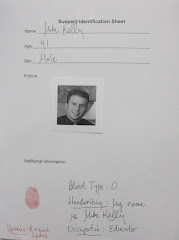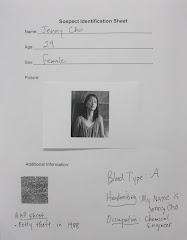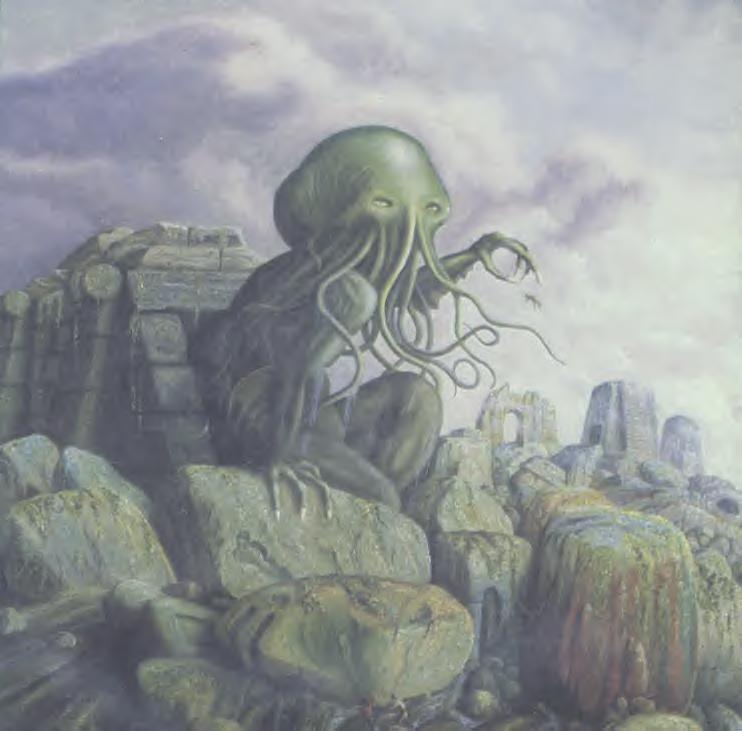Purpose: To solve a simulated crime using the given clues and what we've learned about forensics. Procedure: Use microscopes, blood antigens, and powders on clues to solve the crime.
Group A: Alyssa, Ian, Mary, Olivia.
Crime: Suspected robbery.
Data:
Blood - A [Jenny Cho, Ralph Johnson]
Hair - 1: Black or Asian / 2: White [Jenny Cho, Ralph Johnson / Mike Kelly (victim)]
Fingerprint - Ulnar loop [Mike Kelly (victim)]
Handwriting - Ralph Johnson
Fibers - N/A
-----------------------
Evidence -
Empty wallet, belonging to Mike Kelly
Two hairs
A note: "I have your diamond ring."
A fingerprint
Blood
When we arrived at the scene, we immediately assessed it, using our heightened detective super-senses. We divided up to identify the different pieces of evidence, each writing our results down and then double-checking with each other afterward. I compared the ransom note to the suspects' handwriting and found that it was most similar to Ralph Johnson, a 46-year-old African-American college professor. Ian tested the blood and discovered it was type A. The only two suspects with type A blood were Ralph Johnson and Jenny Cho, a 29-year-old Asian-American chemical engineer. Strike two, Mr. Johnson. Alyssa and Mary were already at work looking at the hair samples. First, they found a dark piece of hair, either African-American or Asian. It wasn't looking good for Mr. Johnson or Ms. Cho. It was then that we looked at Jenny Cho more closely and discovered that she had been charged with petty theft in 1988. Suddenly, we had two suspects instead of just one. The second hair was Caucasian. We believed that this belonged to Mike Kelly, a 41-year-old Caucasian educator. Mike Kelly was the owner of the empty wallet, therefore he seemed to be the victim of this crime. When we were done investigating those clues, we all focused on the latent fingerprint placed on the bottom of a beaker. We dusted with carbon powder and analyzed it to be an Ulnar Loop. Mike Kelly was the only suspect with a matching fingerprint, and so it was definitely his [we still regarded him as the victim].
We wrote down our findings and formulated this order of events:
1. Ralph Johnson met Jenny Cho at the university where he taught, for she was one of his students.
2. He learned about her charge for petty theft and together they plotted a robbery, collaborating their scheming minds.
3. Jenny Cho then seduced a Mr. Mike Kelly into a relationship, gaining his trust.
4. Mike Kelly eventually became so fond of Jenny Cho that he decided to propose, hence the diamond ring.
5. Unfortunately, this was the fateful day that Cho and Johnson would put their evil plan to action.
6. Frightened, Kelly fled his house while Cho and Johnson ransacked his house. Johnson found the diamond ring and decided to keep it for himself.
7. Johnson's greed angered Cho, who crippled him for all of the loot, hence Johnson's blood at the scene. Johnson eventually recovered and fled the scene.
Our simpler explanation appeared as this:
1. Ralph Johnson robbed Mike Kelly and got a paper-cut while hastily writing his ransom note.











